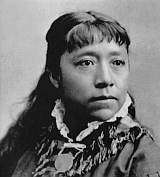Fort McDermitt Paiute and Shoshone Tribe
|
Sarah Winnemucca, a Northern Paiute activist, worked as interpreter, scout and hospital matron at Fort McDermit from 1868 to 1873[1] | |
| Total population | |
|---|---|
| (689 enrolled members (1992)[2]) | |
| Regions with significant populations | |
|
( | |
| Languages | |
| Northern Paiute language, English[3] | |
| Religion | |
| Christianity, Sun Dance,[4] Native American Church, Sun Dance, Traditional Unity Movement[5] | |
| Related ethnic groups | |
| Northern Paiute and Western Shoshone peoples |
The Fort McDermitt Paiute and Shoshone Tribe is a federally recognized tribe of Northern Paiute and Western Shoshone peoples, located at McDermitt, Nevada and Oregon.[6]
The tribe intermittently hosts an annual Indian rodeo in June, on Fathers Day.[7]
Reservation
The Fort McDermitt Indian Reservation spans the Nevada–Oregon border, in Humboldt County, Nevada and Malheur County, Oregon,[8] near the Quinn River, which runs through the Tribe's Nevada lands, east to west. The Fort McDermitt Military Reservation was established 14 August 1865 at the former site of Quinn River Camp No. 33 and a stagecoach stop, Quinn River Station, in what was a traditional seasonal homeland of the Paiute, Shoshone and Bannock peoples. Originally the fort was established to protect the stagecoach route from Virginia City through Winnemucca, Nevada to Silver City, Idaho Territory. It was named after Lt. Col. Charles McDermit, commander of the Military District of Nevada, who was killed in a skirmish in the area in 1865.[9][10]
When the military outpost was closed in 1889, the Military Reservation was adapted as the Fort McDermitt Indian Agency. In 1936 the Indian reservation was established, when the tribe organized under the Indian Reorganization Act of 1934.[11][7] In exchange for giving up the hereditary leadership which opposed the taking of critical environments and sacred places by non-Indians, which experts state was at least 2,800 square miles of what is now Oregon and Nevada, and giving up their traditional name (Red Mountain Dwellers) for an speakable English name, an elected form of government, and limits on their authority, were created by a Constitution and ByLaws and Corporate Charter (drafted by the federal government and containing provisions not required by the Indian Reorganization Act of 1934. Only 54 of 65 available voters on May 6, 1936 voted to approve the Constitution and ByLaws and Corporate Charter. The siren song of economic development promised by the IRA never occurred on the reserved lands (reservation) of the Tribe. The reservation has 16,354 acres in Nevada and 19,000 acres in Oregon. As of the 2010 census, 313 Indians lived on the reservation, with 42 enrolled members living in nearby McDermitt.[12][8] There are more tribal members than enrolled tribal members living on the Reservation. The Tribe's Constitution mandates three classes of People who are tribal members (the "original allottees, and [at birth] such of their descendants [who] maintain a bona-fide residence on the [Reservation]", and "every child of one-fourth or more Indian blood both of whose parents are members of the . . . Tribe" (see Constitution and ByLaws, Article II, Section 1(a), (b))). Thus these People need not be "enrolled". The Constitution and ByLaws allow the Tribal Council to enroll two classes of People; see id., Article II, Section 2(a),(b). The confusion was created in the 1980s, when, at the suggestion of federal officials when Northern Paiute land claims funds were about to be disbursed, the Tribal Council enacted an "Enrollment Ordinance" that declared the Tribal Council had the sole authority, without addressing the Article II, Section 1(a) and (b) conflict, to determine who were enrolled members of the Tribe.
Government
The Fort McDermitt Tribe is headquartered at the Fort McDermitt Indian Reservation, near McDermitt, Nevada. The tribe is governed by an elected eight-member tribal council.[2] Tildon Smart currently serves as Tribal Chairman, and Ione Crutcher serves as the Tribal Council Secretary.[13]
Language
The tribe speaks the Northern Paiute language, also known as Paviotso, which is a Western Numic language. Fort McDermitt has the greatest concentration of Northern Paiute speakers among the various locations where they live. 20-30% of the tribe's children can speak the language.[3]
Notable tribal members and residents
- Sarah Winnemucca[7]
- Chief Winnemucca, also known as Old Winnemucca, Sarah's father and a war leader
References
- ↑ Canfield, Gae Whitney (1988). Sarah Winnemucca of the Northern Paiutes. Norman, OK: University of Oklahoma Press. p. 55-76. ISBN 9780806120904.
- 1 2 Pritzker 226
- 1 2 "Paiute, Northern.", Ethnologue, Retrieved 2 June 2013.
- ↑ Pritzker 227
- ↑ Pritzker 223
- ↑ "Tribal Directory." National Congress of American Indians. Retrieved 2 June 2013.
- 1 2 3 Johnston, Charlie. "Reservations & Colonies." Nevada Magazine. July/August 2011. Retrieved 2 June 2013.
- 1 2 Pritzker 241
- ↑ McArthur, Lewis A.; McArthur, Lewis L. (2003) [First published 1928]. Oregon Geographic Names (7th ed.). Portland, Oregon: Oregon Historical Society Press. p. 624. ISBN 9780875952772. OCLC 53075956.
- ↑ "McDermit, Charles" (pdf). Carson City Consolidated Municipality. Retrieved 2011-08-25.
- ↑ "Winnemucca to Silver City Wagon Road". Bureau of Land Management. Retrieved 2011-08-26.
- ↑ "2010 Census Data". U.S. Census Bureau. Retrieved 2011-08-24.
- ↑ Nevada Indian Commission. "Nevada tribes, ITCN & urban organizations" (pdf). Retrieved 2 Aug 2013.
Further reading
- Barry M. A Native American Encyclopedia: History, Culture, and Peoples, Oxford: Oxford University Press, 2000. ISBN 978-0-19-513877-1
- Constitution and By-Laws of the Fort McDermitt Paiute and Shoshone Tribe
- R. Eagleye Johnny, "Can Indian Tribes Afford to Let the Bureau of Indian Affairs Continue to Negotiate Permits & Leases of Their Resources?", American Indian Law Review 16(1): 201-211 (University of Oklahoma, Norman, 1991)
- Erickson, J.D., Chapman D. and R. Eagleye Johnny, "Monitored Retrievable Storage of Spent Nuclear Fuel in Indian Country: Liability, Sovereignty, and Socioeconomics," American Indian Law Review 19(1): 73-103 (University of Oklahoma, Norman, 1994)
| ||||||||||
Coordinates: 41°55.184′N 117°42.485′W / 41.919733°N 117.708083°W
